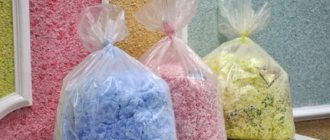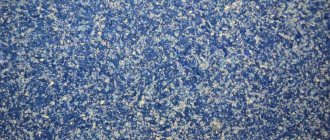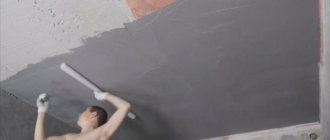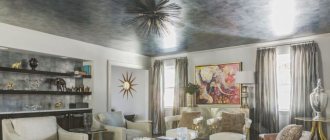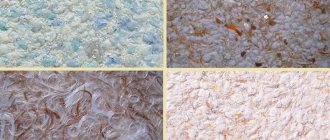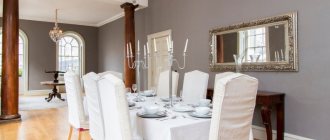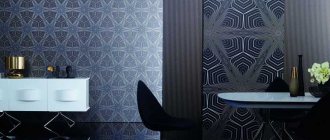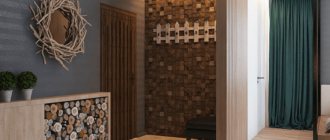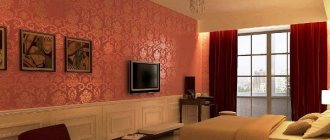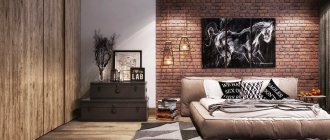Liquid wallpaper for the ceiling is a wonderful option for ceiling decoration, which has become increasingly popular in recent years. Such ceilings look not just stylish, but luxurious. The environmental friendliness of the material captivates the consumer who is at least a little concerned about his health. A long service life of the coating is also important for a person who does not want to turn his life into endless repairs. In a word, this material has plenty of advantages, and as for the difficulties of the production process, within half an hour after the start of work, you will already be confidently working with a trowel, improving the appearance of your home.
Liquid wallpaper for the ceiling: cheaper with your own hands
In our difficult times, inexpensive repairs have become relevant. You can, of course, save on material. But such savings are questionable, because cheap material will most likely not last long.
As for hired labor, there is no guarantee that this repair will be done for you better than you can do it yourself. The fact is that in our age of total unemployment, many “teams” have appeared that are not specialists at all, but pass themselves off as such.
After watching 2-3 videos about applying liquid wallpaper to the ceiling, you will not only have a complete understanding of this work, but you will also be able to do this work perfectly yourself. You will also understand that this is much better and easier than gluing traditional paper, vinyl or non-woven wallpaper to the ceiling. In order to apply liquid wallpaper to the ceiling, you will need the wallpaper itself and a very simple tool.
Liquid wallpaper is a dry mixture used for interior decoration of various rooms.
The mixture may consist of the following components:
- From cellulose;
- Made from cotton;
- Made from wool;
- Made of silk;
- From CMC glue;
- Made from acrylic.
The last two components are the binder. The first four are applicable depending on the type of liquid wallpaper.
Kinds:
- Cellulose;
- Silk. The most durable and most resistant to fading.
- Silk-cellulose.
Cellulose and silk-cellulose wallpapers are somewhat inferior in quality to silk wallpapers, and, of course, cheaper.
Please also pay attention to the rules for choosing wallpaper for the bathroom:.
Tool:
- A container where you need to pour liquid wallpaper for swelling;
- Trowel, trowel or spatula;
- Plastic grater;
- Spray.
Of course, the spray gun will provide some savings in material, but... as a rule, this tool is successfully replaced with the same trowel.
Surface preparation involves removing old wallpaper or whitewash.
Liquid wallpaper can be applied to old surfaces painted with any paint, as well as to glass wallpaper. Before applying liquid wallpaper, the surface is primed.
Varieties
Depending on the composition, liquid wallpaper is divided into three types:
- silk - the highest quality and resistant to ultraviolet radiation, look great and do not lose their original appearance for many years;
- cellulose - economy class coating, inexpensive, but does not have a long service life, quickly fades in the sun, so they can be recommended for the hallway or bathroom;
- cellulose-silk - good price-quality ratio, retain color much longer than wallpaper made from pure cellulose, and have better aesthetic properties, well suited for a bedroom, kitchen or nursery.
They also differ by type of use:
- completely ready for use: they already contain everything you need, all that remains is to dilute them with water (ideal for those who decided to do the repairs on their own, without the involvement of craftsmen);
- requiring special skills: initially they are white, you will have to add dyes and texture components to them yourself (suitable for those who do finishing work on a regular basis, but can cause difficulties for beginners).
How to apply liquid wallpaper to the ceiling: do it right
The technology for applying liquid wallpaper to the ceiling is not fundamentally different from applying it to the walls.
Preparing liquid wallpaper for work is as follows:
- Soak the material from the bag in water at a temperature of 25-30 degrees 12 hours before starting work;
- Each package is prepared separately. Glitter is usually poured in first. Then, after preliminary shaking the contents of the package, in order to thoroughly mix the components, pouring the mixture into water, we achieve a homogeneous mass. It is best to do this with your hands, without fear for your own skin - wallpaper is made on the basis of natural substances. Glitter, by the way, is often not used at all.
- The resulting mixture is again placed in the bag and left to swell for 12 hours.
- After 12 hours, the material can be mixed, divided into required portions and stored, if necessary, for two weeks.
- The walls are primed shortly before wallpaper is applied. The primer is applied in two layers, ensuring the necessary drying. It is not necessary to level the walls perfectly. As for the primer, it is first applied along the ceiling area, and the second layer is applied transversely.
- The finished material should stick well to the wall, without slipping or peeling. If the mixture is not wet enough, you can add water per liter per package. The material is applied with a stainless steel trowel (spatula), in a layer of 1-2 mm.
If you need to renew part of the coating or re-glue it completely, a layer of new coating is applied directly to the old layer. This quality of the material allows you to apply patterns, as well as designs of a different color, and in general, use all sorts of techniques for applying liquid wallpaper of a different color, boldly changing the familiar interior. Anything is possible, as long as everything is done correctly!
During work, the trowel (trowel) should be held at an angle of about 15 degrees, and not with its entire plane.
The next new portion of material must be mixed with the previous one in order to avoid different colors of the coating.
When the ceiling is ready, you need to lightly smooth the material applied to the ceiling with a trowel soaked in water.
Classification of liquid wallpaper
There are several types of liquid wallpaper on sale, which are classified according to the composition of the base. Depending on this criterion, materials differ in the method of application, appearance, durability and practicality during operation, as well as in price. The most popular types of liquid wallpaper are described in detail below.
Pulp
They are the most economical type of materials for finishing the ceiling surface. The adhesive is based on cellulose, the same material used to make paper. Wallpaper of this type has the following distinctive features:
- Easy to spread and apply.
- They are distinguished by a relatively fast polymerization period.
- Low resistance to direct sunlight.
- Disintegrates in a humid environment.
- They wear out quickly under mechanical stress.
- Cellulose fibers are highly susceptible to pigmentation.
- Can be repainted when fading.
- Due to its high adhesion to any type of surface, it sticks to the surface being finished better than other types of wallpaper.
Rice. 8. Cellulose
This type of finishing materials is suitable for ceilings in living rooms and offices. Considering that the ceiling surface is extremely rarely exposed to contact with foreign objects, when installing the material in dry rooms, the above disadvantages can be neglected.
Cotton
This type of finishing composition is used for children's rooms, bedrooms and other living spaces, due to its natural base and improved environmental qualities. Cotton finishing materials intended for ceilings and walls have the following features:
- After drying, the surface acquires an unnoticeable natural shine.
- The polymerized structure based on cotton fiber has increased porosity, which increases vibration absorption, noise protection and thermal insulation characteristics.
- Like cellulose materials, cotton dyes well in volume and is color fast, provided that a high-quality pigment is used.
Rice. 9. Cotton
This product is more expensive than the previous type, but has a longer service life, is not destroyed by ultraviolet radiation, and also tolerates a humid environment better. This property is improved many times over if the wallpaper is coated with interior moisture-resistant varnish.
Silk
The product belongs to a higher price category. The base contains natural silk fibers, which give the wallpaper a glossy shine and a pleasant appearance. Advantages of silk-based materials:
- When polymerized, the composition looks like a fabric surface, which adds individuality and a rich appearance to the room.
- Manufacturers often add special additional components to silk liquid wallpaper, which is why the material imitates the texture and color scheme of natural stone.
- The material in this category contains moisture-resistant polymers that actively resist the effects of a humid environment, which allows it to be used in the kitchen area.
Rice. 10. Silk
The only drawback of such wallpapers is their inflated price, due to the high cost of natural silk.
Combined
To maintain low consumer prices while increasing the quality of materials, many manufacturers produce combined liquid wallpaper. The adhesive mixture is based on a special recipe that includes cellulose, cotton and silk components. This type of coating is the most popular among buyers, since an aesthetic appearance, combined with high quality and performance properties, is achieved at a relatively low cost.
Rice. 11. Combined
Liquid wallpaper for the ceiling: consumer reviews
A relatively “young” material called liquid wallpaper has been successfully “conquering” more and more living spaces in apartments and houses for several years now.
Due to the great many positive qualities of liquid wallpaper, there are a lot of reviews, and all of them are practically positive.
Liquid wallpaper for the ceiling is a very successful material that can significantly change the interior of your home.
So, reviews:
- Easy to apply to the surface, although this has not been done before;
- It is very easy to repair damage caused by children or when rearranging pieces of furniture that have a large height;
- It is easy to repair cracks that appear in the ceiling;
- Not only sound insulation has improved, but also the acoustics in the room;
- They dry quickly, are not afraid of drafts, and this quality speeds up drying;
- The ceiling surface has no joints; it seems that one huge sheet is glued to the ceiling;
- No cracks or small unevenness in the ceiling are visible;
- Dust does not settle on the ceiling;
- If necessary, it is easy to remove a layer of liquid wallpaper;
- There is no need to remove the old layer before applying a new one. A new layer can be applied on top of the old one.
To all the reviews, we can also add that this wallpaper is an environmentally friendly material, as it contains only natural ingredients.
Liquid wallpaper perfectly withstands temperature changes and shrinkage of the house, which is important for dachas and country houses.
Liquid wallpaper is not subject to fading or peeling for a long time - up to 15 years.
You can find out what wallpaper to choose for decorating your kitchen in the following article:
Preparation of the solution
The purchased mixture should be poured into warm water, the optimal temperature is 20-25 degrees. The required quantity is indicated on the package; you should be guided by these data. To get bright colors, you can additionally use colors that are added to the dry mixture and first mixed in this form.
After the mixture is thoroughly mixed in a container with water, you need to obtain a homogeneous solution. If you need to make a large amount of solution, then you can use a mixer.
But you need to set the mixing mode to medium; with a fast mode, air bubbles may get into the composition. They will worsen the properties of the mixture.
In other cases, it is better to choose manual mixing. The container is closed and left to brew for an hour.
To get bright colors, you can additionally use colors that are added to the dry mixture and first mixed in this form.
Liquid white wallpaper for the ceiling: reasons for popularity
The vast majority of consumers are accustomed to seeing white ceilings, and this stereotype is firmly entrenched in the subcortex, especially among conservative people.
However, everything depends not only on conservatism or stereotypes that have developed over almost centuries. It also comes down to such an aspect as design.
Fortunately, in construction and online stores there is an ample selection of wallpaper of any color. White color is no exception.
So, the main reasons for choosing:
- White liquid wallpaper on the ceiling visually expands the rooms.
- Not everyone likes colored ceilings.
However, as an intermediate (between color and white), there is a variant of light colors: light gray, or pale beige, etc. It's all a matter of personal perception, basically. And one more thing: before choosing wallpaper, it’s not a sin to look at photos with different color options, as well as videos.
You will find even more information about the benefits of liquid wallpaper in the following material:.
Technology of applying liquid wallpaper to the ceiling (video)
In conclusion, I would like to note that even a completely inexperienced repairman can work with liquid wallpaper. In addition, during renovation there will be no odors that irritate the sense of smell in the rooms, which allows you to carry out renovations without causing any inconvenience to your household. The process of applying liquid wallpaper is clean, that is, there will be no usual debris during work. You can ventilate the room immediately after finishing work, without waiting for the wallpaper to dry completely - this will not have a negative effect on it. In a word, such a renovation has a lot of advantages! Liquid wallpaper is used in the living room, hallway, and bedroom. It is not advisable to glue in rooms with high humidity! Go for it, and everything will work out great for you!
What comes first: liquid wallpaper or suspended ceiling
In some cases, during repairs, people are faced with the question of what is done first - suspended ceiling or liquid wallpaper.
Stretch ceilings are suspended structures that are made of polyvinyl chloride or woven fabrics mounted on steel, aluminum or plastic profiles. Quite often, such devices are installed on plasterboard walls. This creates a multi-tiered ceiling.
Installing a stretch ceiling is a rather complicated process. When installing the ceiling, the wallpaper can get dirty: therefore, you should install the suspended ceiling first
If wallpaper has already been applied to the walls, then suspended ceilings should be installed only after the liquid building material on the walls has completely hardened to avoid deformation and damage. When installing a stretch ceiling, liquid wallpaper must be covered with polyethylene to prevent dust from settling on it.
Reviews say that the ideal option is to install a suspended ceiling before applying liquid wallpaper to the walls. The advantage of this option is complete protection from dust, which appears during the installation of the suspended ceiling frame.
